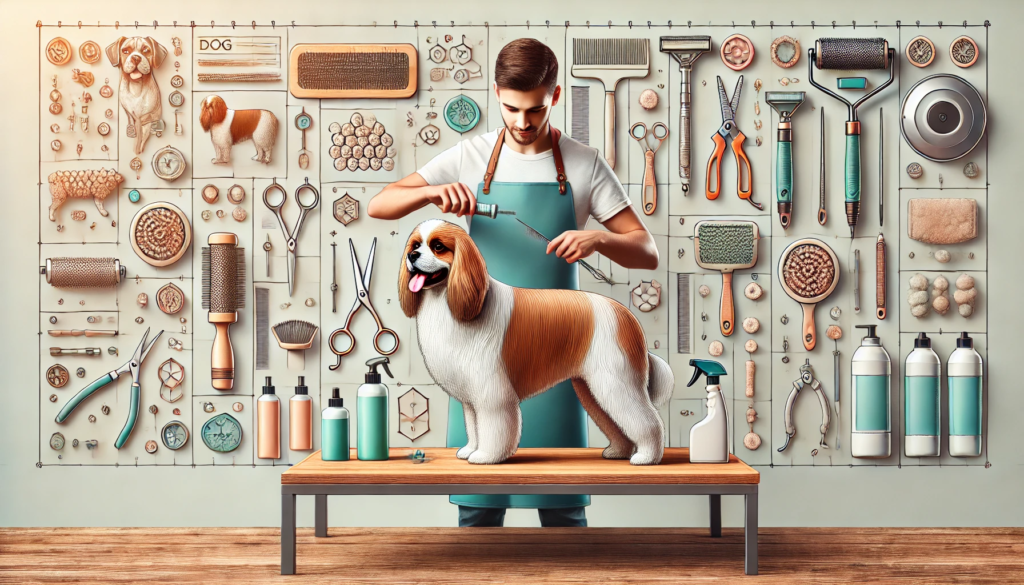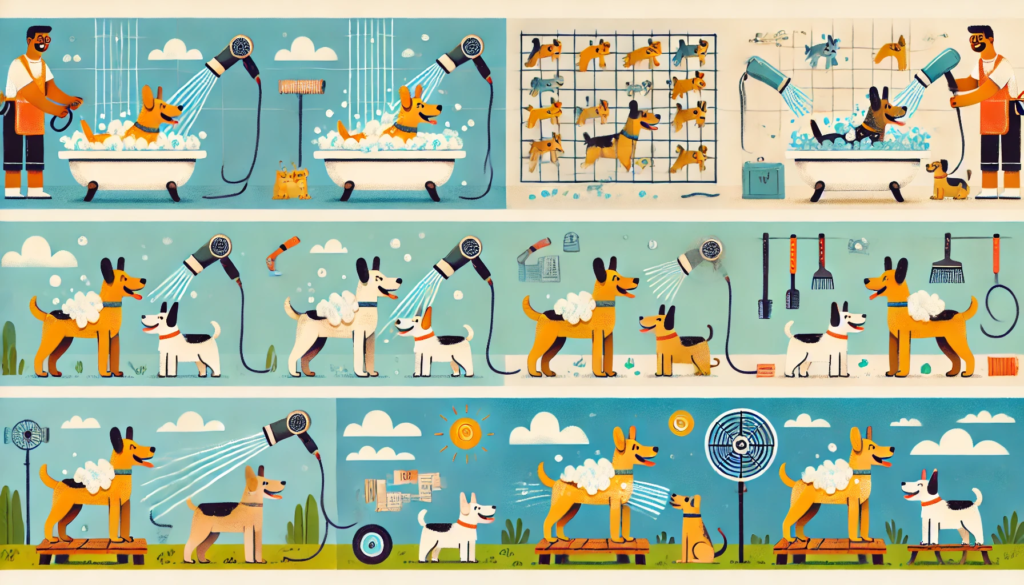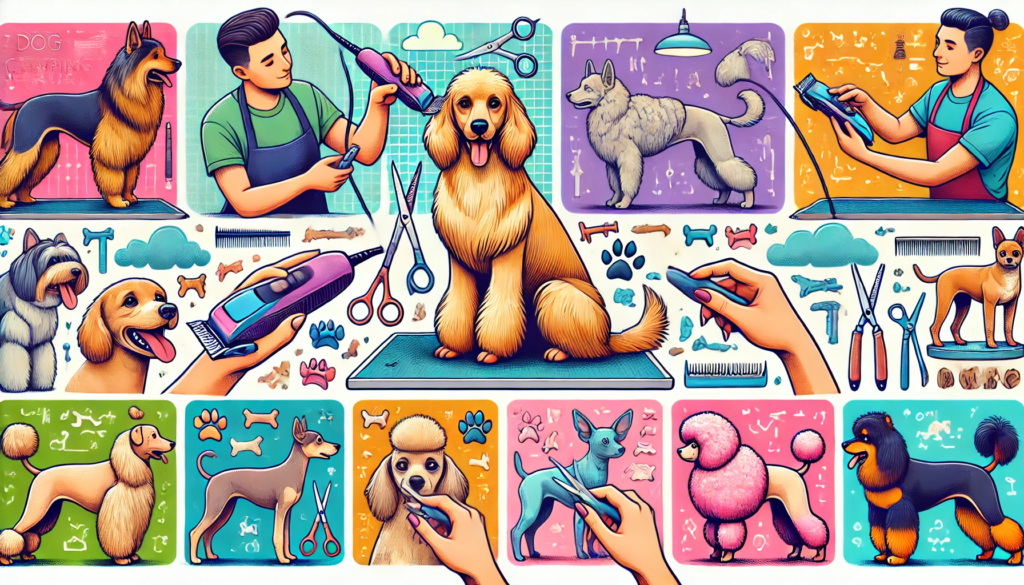
Grooming your dog is not just about keeping your furry friend looking cute and clean. It’s also crucial for their overall health and well-being. Whether you’re a seasoned pet owner or a newbie, mastering the basics of dog grooming can make a huge difference in your pet’s life.
In this comprehensive guide, we’ll explore top dog grooming techniques, including bathing and drying methods, clipping and trimming techniques, brushing and detangling strategies, ear-cleaning procedures, and dental care routines.
Bathing and Drying Methods

Bathing your dog is one of the fundamental grooming tasks that you’ll need to perform regularly. Proper bathing techniques ensure that your dog’s coat remains clean and free of dirt, allergens, and parasites.
It also allows you to inspect your dog’s skin for any abnormalities such as lumps, bumps, or signs of irritation. Regular baths can also reduce shedding and make your dog more pleasant to be around.
How Often Should You Bathe Your Dog?
The frequency of baths depends on your dog’s breed, coat type, and lifestyle. Dogs with oily coats, like Basset Hounds, may need a bath once a week to manage the oiliness and odor.
On the other hand, dogs with water-repellent coats, such as Golden Retrievers, should be bathed less frequently, perhaps once every few months, to maintain their natural oils. Active dogs who spend a lot of time outdoors may need more frequent baths compared to dogs who mostly stay indoors.
Steps for a Proper Bath
- Brush Before Bathing: Remove any loose fur and detangle mats to make bathing easier and more effective. This will also prevent mats from getting tighter during the bath.
- Use Lukewarm Water: Ensure the water temperature is comfortable for your dog to prevent stress or discomfort. Extreme temperatures can cause anxiety and make the bathing process unpleasant.
- Choose the Right Shampoo: Use a dog-specific shampoo, as human shampoos can be too harsh for your dog’s skin. Look for shampoos that cater to your dog’s specific needs, such as sensitive skin, flea control, or moisturizing.
- Rinse Thoroughly: Make sure all shampoo is rinsed out to prevent skin irritation. Residual shampoo can cause itching and dryness.
- Dry Properly: Use a towel to blot dry your dog’s coat. For dogs with long or dense fur, you might need a pet dryer to avoid mats and mildew. Ensure your dog is completely dry before allowing them to go outside to prevent them from getting cold or rolling in dirt.
Clipping and Trimming Techniques

Regular clipping and trimming are essential to keep your dog’s coat neat and manageable. It also helps in preventing issues like matting and overgrown nails, which can lead to discomfort and health problems. Clipping and trimming also give you a chance to check for any skin issues or parasites that might be hidden under the fur.
Tools You Will Need
- Clippers: Invest in a high-quality clipper with adjustable blades. This will ensure a smooth cut and reduce the risk of injury.
- Scissors: Use grooming scissors for precision trimming. These are particularly useful for delicate areas such as around the face and paws.
- Nail Clippers: Choose a clipper that suits the size of your dog’s nails. Different breeds require different sizes and types of nail clippers.
- Styptic Powder: Handy for stopping any bleeding if you accidentally cut the quick. Having this on hand can save you a trip to the vet.
Clipping the Coat
- Start with a Clean Coat: Make sure your dog’s coat is clean and dry before you begin clipping. This makes the process smoother and prevents clogging the clipper blades.
- Go with the Grain: Always clip in the direction of hair growth to avoid cutting too close to the skin. Clipping against the grain can cause irritation and uneven cuts.
- Use Guards: Clippers come with different guard lengths. Choose the right one for your desired coat length. This helps in achieving a uniform cut and prevents accidental nicks.
Trimming the Nails
- Hold the Paw Firmly: This helps to keep your dog steady during the process. A steady paw reduces the risk of cutting the quick.
- Trim Small Amounts: Cut a small portion of the nail at a time to avoid hitting the quick. If you’re unsure, trim less and more frequently.
- Use Styptic Powder: In case of any bleeding, apply styptic powder to stop it quickly. It’s a good idea to have this ready before you start trimming.
Brushing and Detangling Techniques

Brushing your dog’s coat is crucial for maintaining its health and appearance. It helps distribute natural oils, removes loose fur, and prevents matting. Regular brushing sessions also provide an opportunity to bond with your dog and check for any unusual skin conditions.
Choosing the Right Brush
The type of brush you need depends on your dog’s coat type:
- Slicker Brush: Ideal for removing mats and tangles in medium to long-haired dogs. Its fine bristles are effective in getting through dense fur.
- Bristle Brush: Suitable for short-haired breeds to remove loose fur and dirt. It also helps in distributing natural oils across the coat.
- Undercoat Rake: Perfect for dogs with a thick undercoat to remove dead hair. This tool is essential during shedding season to keep your dog’s coat manageable.
How to Brush Your Dog
- Start Slowly: Begin brushing gently to get your dog accustomed to the sensation. Gradually increase the pressure as your dog becomes more comfortable.
- Focus on Problem Areas: Pay extra attention to areas prone to matting, like behind the ears and under the legs. These spots are often overlooked but can become severely matted if not tended to.
- Use Detangling Spray: For tough mats, use a detangling spray to make the process easier. This can also reduce the discomfort your dog might feel during brushing.
Ear Cleaning Techniques

Cleaning your dog’s ears is another vital aspect of grooming. Regular ear cleaning can prevent infections and discomfort. It’s especially important for breeds with floppy ears, which are more prone to ear infections.
Steps for Cleaning Ears
- Check for Signs of Infection: Before cleaning, look for redness, swelling, or a foul odor, which may indicate an infection. If you notice any of these signs, consult your vet before proceeding.
- Use Dog-Specific Ear Cleaner: Avoid using human products as they can irritate your dog’s ears. Dog-specific cleaners are formulated to be gentle and effective.
- Apply Cleaner: Gently squirt the cleaner into your dog’s ear canal. Be careful not to insert the applicator too deeply.
- Massage the Base: Massage the base of the ear to help the cleaner break up any debris. This also helps to distribute the cleaner evenly.
- Wipe Away Excess: Use a cotton ball to wipe away any dirt and cleaner. Avoid using cotton swabs as they can push debris further into the ear canal.
Dental Care Techniques

Oral hygiene is often overlooked but is essential for your dog’s health. Regular dental care can prevent gum disease, bad breath, and tooth loss. Good oral hygiene can also contribute to your dog’s overall health, as dental issues can lead to more serious health problems.
Brushing Your Dog’s Teeth
- Use Dog Toothpaste: Human toothpaste can be harmful to dogs, so always use a product designed for pets. Dog toothpaste comes in flavors that are appealing to dogs, making the process easier.
- Choose the Right Toothbrush: Use a dog-specific toothbrush or a finger brush. These are designed to fit comfortably in your dog’s mouth and reach all the teeth.
- Brush Gently: Start by brushing a few teeth at a time and gradually increase the number of teeth you brush. Be gentle to avoid causing discomfort or injury.
- Reward Your Dog: Give your dog a treat or praise to make the experience positive. This will make future brushing sessions easier.
Dental Chews and Toys
Supplement brushing with dental chews and toys to help clean your dog’s teeth and massage their gums. Look for products approved by veterinary dental associations for added assurance. These products can help reduce plaque and tartar buildup and keep your dog’s breath fresh.
Conclusion
Mastering these dog grooming techniques will not only keep your dog looking great but also contribute to their overall health and happiness. Regular grooming sessions are an excellent opportunity to bond with your pet and keep an eye out for any potential health issues. So, roll up your sleeves and make grooming a fun and rewarding experience for both you and your furry friend!
By following these top grooming techniques, you’ll ensure that your dog stays clean, healthy, and happy.
